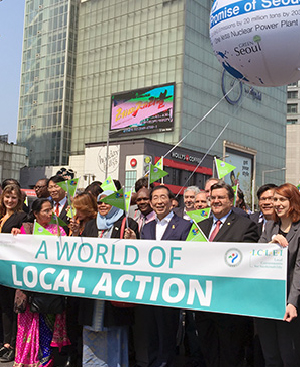- Home
- Reporting entities
- Nagoya City
Nagoya City
Japan Mayor: Takashi Kawamura-
Population 2268217

-
Area 326.0km 2
-
GDP N/AN/A
-
Targets by N/A N/Aemission
Targets by Nagoya City
There are no targets yet
- Start year: 2009
- Type: Technical/Infrastructure investment
- Status: In operation
Nagoya subsidizes installation of home-use solar power
generators and thermal power systems to expand natural
energy use. In FY 2011, the City provided subsidies for 2092
solar power generators (a 9230 kW power output), and in
FY 2012 will provide 2200 such subsidies (8800 kW power
output).
- Residential
- Start year: 2007
- Type: Education/Awareness Raising
- Status: Completed
There has been total output reduction of 430,000 metric
tons of CO2 from FY 2007 to FY 2009 as part of the “Global
Warming Countermeasures Plan” system that encourages
big businesses to voluntarily combat global warming (plans
were submitted from FY 2004 to FY 2006). For small- and
medium-sized businesses, the City offers advice for energy
savings via energy consultants and pamphlets ordered by
business type. Consultants conducted 1850 visits starting in
FY 2009 and realized 627 visits in FY 2011.
- Other Emissions

- Start year: 2004
- Type: Regulatory
- Status: In operation
Please inquire JO ([email protected]) for more information.
Read More Read Less- Commercial
- Industrial
- Transport
- Industrial processes and product use (IPPU)
- Agriculture, Forest and Other Land Use (AFOLU)
- Waste
- Start year: 2007
- Type: Education/Awareness Raising
- Status: In operation
Please inquire JO ([email protected]) for more information.
Read More Read Less- Residential
- Commercial
- Waste
- Start year: 2008
- Type: Education/Awareness Raising
- Status: In operation
Please inquire JO ([email protected]) for more information.
Read More Read Less- Commercial
- Industrial
- Transport
- Industrial processes and product use (IPPU)
- Start year: 2013
- Type: Technical/Infrastructure investment
- Status: In operation
Nagoya City purchases and leases photovoltaic systems or rents out roofs of city-owned buildings to expand renewable energy usage and work towards a low-carbon society. The leasing and roof rental project was launched in 2013, through which 925kW and 378kW solar systems were installed respectively.
Read More Read Less- Buildings
- Facilities

- Start year: 2008
- Type: Education/Awareness Raising
- Status: In operation
In Nagoya, ratio of car use is higher than that of other cities and per-capita CO2 emission in transportation sector is 50% higher than the big-city average. As CO2 emissions from cars accounts for 25% of the city’s total output, it has been an urgent issue to take measures against car-caused emissions. Therefore, Nagoya city promotes “Eco-Drive” which has an effect on reducing exhaust gases as a car-related environmental measure. In order to promote Eco-Drive at businesses, it is important not only to change the mindset of drivers, but also to make a joint effort by business operators, managements and drivers. For this reason, in 2008, Nagoya city started the program to foster Eco Drive leaders by accrediting those who actively promote the practice at their workplace as “Eco Drive Meister”. We hold Eco Drive seminars for businesses with a training session to accredit Eco Drive Meisters.
Number of “Eco Drive Meister” is 2,005 (compared to 646 in 2010)
- Transport
- Start year: 2008
- Type: Policy/Strategies/Action Plans
- Status: In operation
In recent years, green area in Nagoya has been decreasing, especially in private land that accounts for about two thirds of the city’s entire area. Therefore, we have introduced the Green Space Program since 31st Oct. 2008 to create green-space and to mitigate heat island effect involving the city, the citizen and businesses all together.
The program, the first of its kind in Japan, calls for an area-based greening requirement on larger land plots (300㎡ or greater) where new construction or extension is taking place.
Results between Oct 31, 2008 - Mar. 31, 2014 include 7,329 applicants, 1452.5ha of reported land area, and 255.7ha of green space, leading to an average greening rate of 17.6%.
- Start year: 2009
- Type: Education/Awareness Raising
- Status: In operation
Urbanization has meant that much of Nagoya is covered by asphalt and concrete. During heavy rains, water flows directly into sewers and renders the city flood prone. By blocking flood-causing runoff via absorption and rainwater catchment, rainwater will not accumulate in sewers, an effective flooding counter-measure. Nagoya also drafted an “Osmosis Suitability Map” that sectioned the city by color with regard to rainwater absorption possibilities; the city is installing rainwater absorption facilities on an ongoing basis.
Read More Read LessThe Nagoya City has reported 3 Community emission inventories, since 2008. In its latest inventory, compiled in 2011, the Stationary energy, Transport, Waste management, Agriculture, forest and other land use and Agriculture, forest and other land use are identified as key emission sources.
The Nagoya City has reported 3 government operational inventories, since 2009. In its latest inventory, compiled in 2013, the Waste management, Transport, Other and Agriculture, forest and other land use are identified as key emission sources.
Mayor Takashi KawamuraNagoya City, Japan


